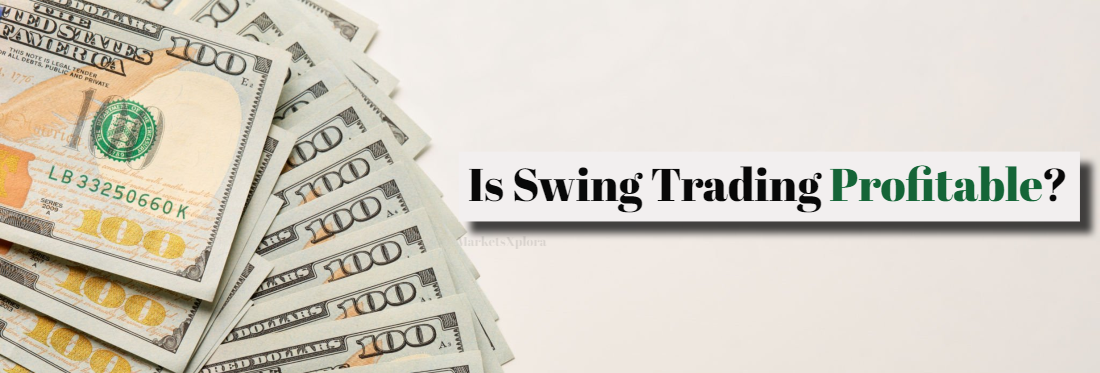
Many new traders are attracted to swing trading, which involves holding trades from 2-3 days to 2-3 weeks aiming to profit from short-term price swings. But the most common question beginners ask is – is swing trading profitable?
This is an important question and you need a good answer to it before committing your hard-earned capital.
So what exactly constitutes this trading approach? In essence, swing trading sits between day trading and long-term position trading. Swing traders identify trading opportunities across these timeframes based on technical and fundamental analysis, enter positions at opportune points, and hold them for the expected profitable swing duration while minimizing downside risk along the way.
Now let’s find out whether swing trading offers REAL profit consistency or just fanciful hopes not backed by reality…
Is Swing Trading Profitable? The Risks and Rewards
Put simply – yes, it can provide very attractive returns over time if executed prudently. However, profitability depends greatly on developing expertise around risks, rewards, and probabilities.
A reasonable profit target per swing trade would be 100+ pips. Allowing winning trades to fully play out substantially grows potential gains. Although swing trading sees less frequent trading opportunities than aggressive day trading, it enables larger position sizes targeting bigger swings.
Skilled swing traders can achieve estimated yearly returns between +20% on the low end to 50%+ in strong market conditions. Controlling trade sizing, using wide yet prudent stop losses to avoid premature exits, and mastering both fundamental and technical analysis helps tip odds favorably.
While no trading eliminates risks, swing trading provides flexible part-time profit potential. By honing strategy over long series of trades and weathering short-term fluctuations, one can compound account growth well above passive buy-and-hold returns.
Now that we’ve examined the risk-reward considerations, next, let’s discuss what helps swing traders make profits…
Traits and Skills Needed to Make Profits
New swing traders often lack patience, overtrading inferior setups. They exit winners prematurely or hold losers hoping they’ll recover. Developing composure and discipline to only trade high-confidence scenarios protects capital and avoids rash decisions.
Additionally, properly identifying textbook swing trade entries requires mastering analysis. For example, combine a bullish price crossover on the daily with an oversold RSI divergence on the 4-hour around a key support level to plan excellent long trades.
Also, confidently pulling the trigger once your entry signals align takes conviction. If your backtested edge has a 65% strike rate, trust executing it without hesitation despite short-term uncertainties. Follow the blueprint.
Finally, setting profit targets 2-3x initial risk allows exceptional reward over many trades. If the stop is 50 pips, aim for 100-150 pip profit. This mathematical edge compounds gains over time despite 35% failed trades.
Deliberately developing analysis ability, conviction in your edge, risk/reward aptitude and patience transforms the probabilities of profitable swing trading tremendously. Skills trump traits.
Factors Influencing Swing Trading Profitability
By analyzing the following factors, you can maximize swing trading profitability:
-
Account size
Account size matters when it comes to handling risk properly. If starting out swing trading stocks with a $2000 account, even 5-10% gains on a couple of successful trades may only produce $100-200 profits. Whereas a $20,000 account could fruitfully handle larger position sizes and generate five figure returns. Match account and position scale.
-
Instruments and markets traded
Instruments impact results as well. Forex markets swing aggressively suiting swing trades. Stocks require more capital to generate meaningful swing trade gains, but crypto remains extremely volatile. Choose markets that suit account size and personality. Active forex swings widely appeal across capital tiers with 24/7 accessibility.
-
Leverage and fees
Leverage requires prudent use to avoid oversized position risks. While 2:1 or 3:1 leverage may afford ample position sizing capacity, also respect overnight gap or extreme volatility risks accordingly. Manage trade size smartly.
-
Tax considerations
Taxes also determine net results, so don’t overlook it. For example, if placed in the 32% income tax bracket, a $20,000 short-term swing trade gain may face ~$6400 tax reduction. Holding instruments past one year drops this to just 15% long-term capital gains taxes, saving thousands.
As we can see, swing trading success hinges greatly on money management tailored to personal constraints around capital, instruments traded, temperament, and taxes – not the innate viability of swing trading alone. Align these pillars properly to your needs and profitability follows.
How Much Profit Should You Expect?
“How much and how fast can I realistically expect to earn swing trading?” Simple question, but the answer requires nuance rather than hype. While tales of turning $10k into $1 million in a few years tempt the imagination, pragmatic traders acknowledge the swings and roundabouts to get there.

Consistency is key to profitability. Compounding 20-30% annually provides admirable returns and prevents large drawdowns from derailing progress when inevitable losses hit. Traders recording big streaky home runs likely endured some gut wrenching slumps along the way too.
An ambitious yet grounded $50k account growing 25% yearly nets approximately $315,000 over 5 years. But know monthly performance fluctuates wildly across that average. Mature traders accept short-term uncertainty, while the long-term process of refining slightly favorable odds arbitrages randomness over hundreds of trades.
So while swing trading can achieve extremely impressive compounded gains over time, smooth upward progress hides the rollercoaster required getting there. Set ambitious yet reasonable profit goals, master your skills, trade wisely, and remain confident through ups and downs until experience bears the financial fruits.
Profit-Maximizing Keys for Beginners
What should you do if you want to increase your chances of consistently earning like a seasoned swing trading pro? First thing first, get properly schooled before risking real money! No successful trader bypassed education and hard knocks through fabled shortcuts…put your time in.
Remember, you’re competing against ruthless quant PhDs and grizzled pit veterans destroying amateurs daily. Think progress not perfection at the start. Set conservative profitability goals allowing flexibility to be wrong and improve. 25% yearly seems very achievable long-term.
When initiating trades, use those stop losses religiously! They protect capital to play another day when you’re eventually right big. You MUST kill transactional ego and contain those position sized bets with discipline during tough phases.
Finally, resist seductions to overtrade on a whim without signals just for action’s sake. Newbies forfeit account gains not from stop outs, but abandoning plans on mediocre trade ideas. Patience grasshopper! Wait for your A+ setups before pulling the trigger.
The keys exist through personalized education, reasonable objectives, risk control, and developing maturity. Do the work upfront and profitability will unfold!
Is Swing Trading Profitable? – Wrapping Up
Yes, swing trading can provide very profitable returns over time for disciplined traders who master the necessary skills. Successful trading swing requires:
- Developing expertise in analysis, planning, risk management, and emotional control
- Setting reasonable profit goals and then optimizing strengths around proven statistics
- Accepting uncertainty, while deliberating and honing skills over the years
Study hard, prepare diligently, execute trades with steely discipline focused on process over results. Put in your 10,000 hours and regulatory riches follow by filtering complexity into simplicity. Master self first, then master the market.
FAQs
- What profits can a beginner swing trader reasonably expect?
Aim for consistent 15-25% annual returns early on. This allows room for refinements over time. Avoid unrealistic goals that may lead to overtrading and frustration.
- Does swing trading profitability rely more on markets or trader skill?
Mastering risk management, emotions, planning, analysis and execution separate the profitable from gamblers. Markets simply determine when those skills apply.
- How many losing trades should a profitable trader expect?
Expect 40-50% of trades to hit stops. Profitability relies on winners being substantially larger over many trades due to favorable risk-reward ratios.
- How much capital is required to swing trade profitably?
Considerable account size fluctuations happen before positive expectancy plays out. Start with enough capital to facilitate your instrument, leverage and style. $10k+ recommended.
- How long does it take to become a profitable swing trader?
Consistency develops over hundreds of trades. Most dedicate 2-3 years immersed honing strategy, psychology and risk management expertise specifically before generating reliable income trading.
